Unintentionally coinciding with today’s International Women’s Day – really, it was a complete accident – this week our Listed section looks at “pink Champagne”, namely the five most expensive rosé Champagnes. We are a bit embarrassed that it looks like we are jumping on the bandwagon and touting the colour pink today. However, as these five contenders show, top rosé Champagne represents a serious vinous offering worthy of any day or occasion.
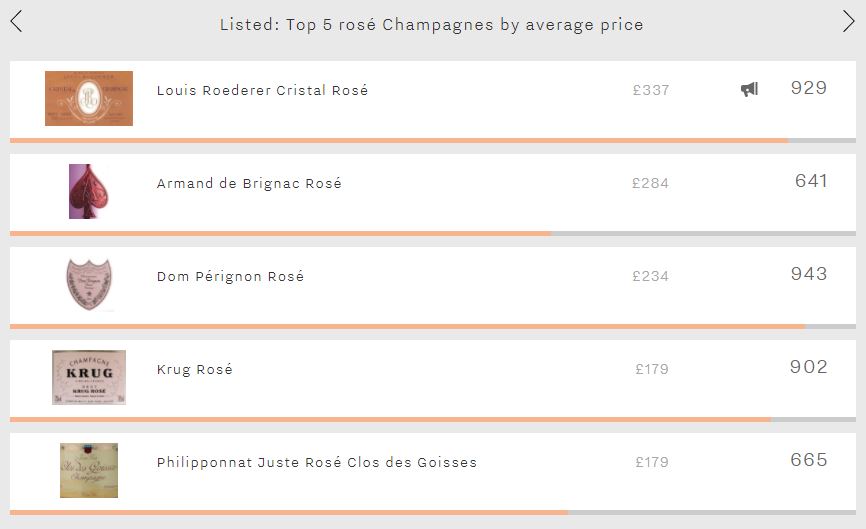
The world’s most expensive pink Champagne is Louis Roederer’s Cristal Rosé (£337 per bottle). It also achieves the highest Quality score of all rosé Champagnes (972). Whilst it receives excellent scores from each of Wine Lister’s partner critics, it is the outstanding average rating of 97/100 from Antonio Galloni’s Vinous that stands out. Cristal Rosé also pips its white counterpart to the post in the Quality category (972 vs 970), and is over twice as expensive (£337 vs £165 per bottle). However, despite its superior quality, Cristal Rosé trails its white counterpart in the Brand category by 56 points – it features on under half as many of the world’s top wine lists and is searched for 82% less frequently.
The second-most expensive rosé, Armand de Brignac’s offering, is a newcomer to the fine wine world, born in 2006. It experiences the group’s lowest Quality and Economics scores, and second-weakest Brand score. Its high price (£284) can therefore be attributed to its association with Jay-Z. The American rapper featured Armand de Brignac’s white Champagne in the video for “Show Me What You Got” in 2006 – before it even had a US importer – and eventually bought a significant portion of the house in 2014, further aligning the brand with his high-flying lifestyle.
In third place is Dom Pérignon’s rosé (£234). Whilst unable to match the peerless brand recognition of its white counterpart, it does enjoy the best Brand score of any pink Champagne (984). This is thanks to receiving on average 2.5 times as many online searches each month as the second-most popular wine of the five (Cristal Rosé).
The last two spots are filled by Krug’s rosé and Philipponnat Juste Rosé Clos des Goisses, each costing £179. The fact that the Krug enjoys a lead of 237 points in terms of overall Wine Lister score yet costs the same shows that when it comes to rosé Champagne, prices don’t always have a rational explanation. The chart below confirms a lack of correlation between price and overall Wine Lister score for these five wines.
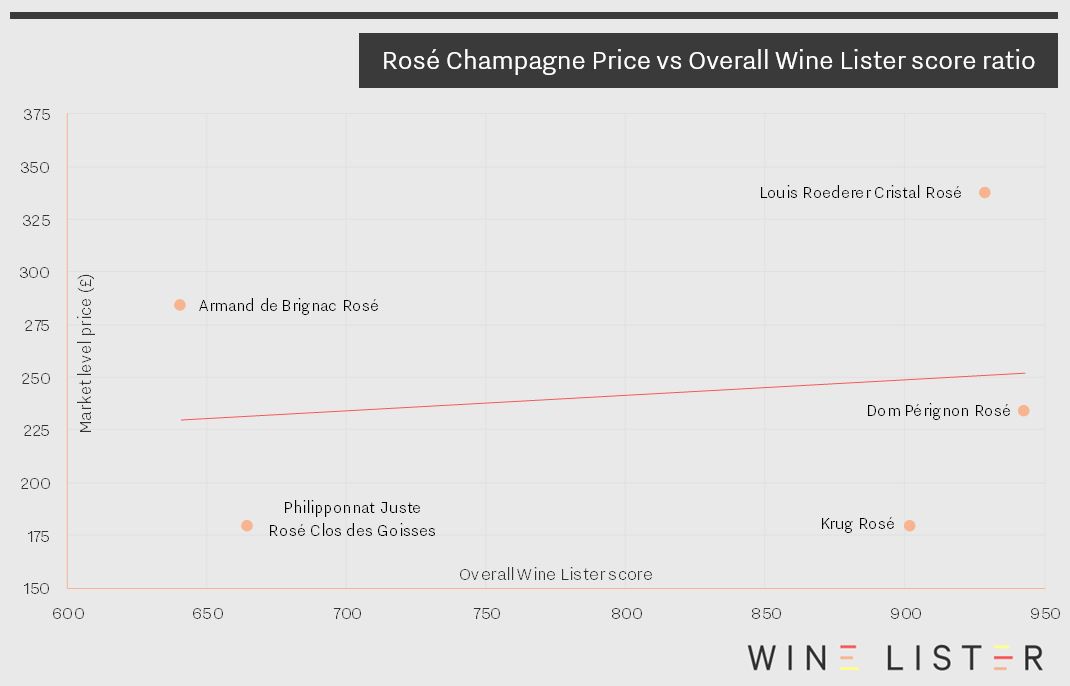
This week, Wine Lister determinedly battles through the cold to bring on spring with the vinous ray of sunshine that is Sauvignon Blanc. The Loire valley is, for many, the holy grail of Sauvignon Blanc production, creating pure, age-worthy examples of the grape. Interestingly, Wine Lister’s top five Loire Valley dry whites for Quality all hail from the Easternmost tip of the Valley – Pouilly-Fumé and Sancerre – thus edging out stiff competition from the more Westerly Chenin Blancs.
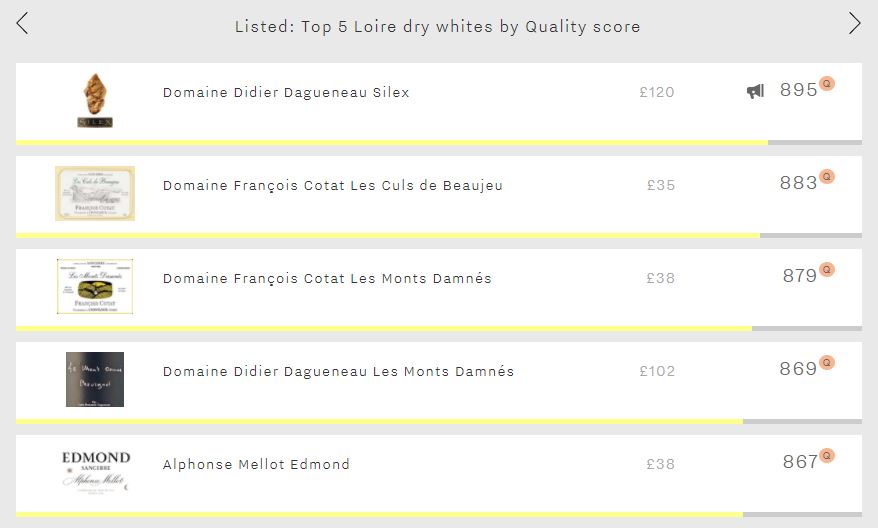
Whilst none of the top five breach the 900-point mark – thus not quite making it into the most elite band of Wine Lister’s 1,000-point scale – they don’t miss out by far, and are separated by just 28 points. Notably, two producers dominate – Dagueneau and François Cotat – filling four spots, with Alphonse Mellot’s Edmond taking the remaining place.
In top spot is Dagueneau’s Silex with a score of 895. This iconic Pouilly-Fumé – or Blanc Fumé de Pouilly as the domaine refers to it – might not be the Loire’s longest-lived dry white, but leads thanks to excellent critics’ ratings, with French duo Bettane+Desseauve awarding it 18.5/20 on average. Not only is it the Loire’s top dry white for quality, it also achieves the best Brand score of any Loire Valley wine – it is 68% more popular than any other wine from the region and its famous flint-emblazoned bottle is visible in 39% of the world’s top restaurants.
Second and third spots are taken by two Sancerres from François Cotat – Les Culs de Beaujeu (883) and Les Monts Damnés (879). François Cotat, along with his cousin Pascal inherited their respective domaines when their fathers – Paul and Francis – retired in the early 90s. The cousins decided to split production, with François continuing to make his wines in Chavignol, whilst Pascal built a new winery in Sancerre. François’ Les Culs de Beaujeu and Les Monts Damnés comfortably achieve the longest drinking windows of this week’s top five – 12 and 13 years respectively – at least three years longer than the remainder of the group.
Fourth and fifth spots are filled by Dagueneau’s Les Monts Damnés (869) and Alphonse Mellot’s Edmond (867). Whilst they are separated by just two points in terms of Quality, the former is over 2.5 times more expensive, perhaps thanks to Domaine Dagueneau’s cult status.
Having stopped off last week in Syrah’s spiritual home – the Northern Rhône – in search of the region’s leading wines for the 2015 vintage, this week Wine Lister’s Listed section ventures to Australia, surely Syrah’s most famous home from home. Australian Shiraz might differ stylistically from the Northern Rhône’s finest Syrahs, but the Land Down Under’s foremost brands have certainly managed to establish themselves as a force to be reckoned with on the international fine wine market.
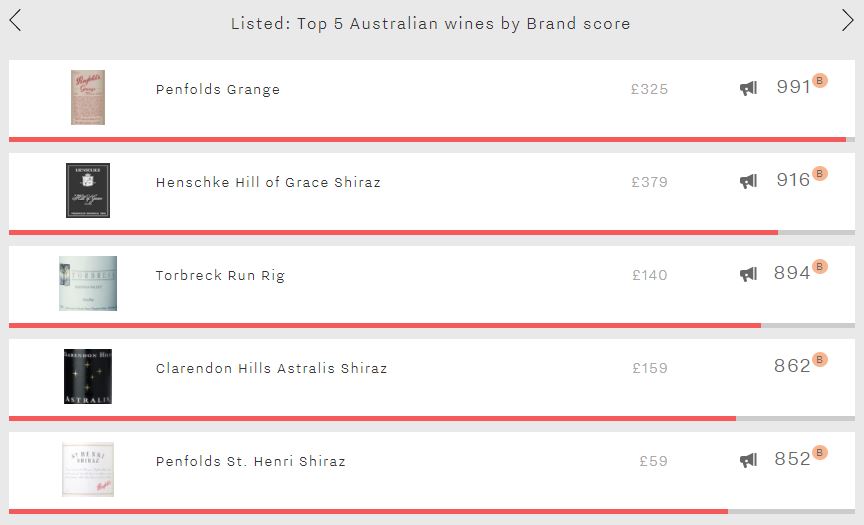
Penfolds’ flagship Grange is Australia’s runaway leader in the Brand category. Its formidable score of 991 is not only 75 points ahead of Australia’s second strongest brand – Henschke Hill of Grace Shiraz – but also nudges ahead of the Northern Rhône’s top brand – Jaboulet Hermitage La Chapelle. Whilst Grange can’t quite match La Chapelle in terms of the number of the world’s top restaurants in which it features (34% vs 43%), establishments in which it does appear list 1.5 times more vintages / formats on average (4.5 vs 3.0). Grange is also considerably more popular than La Chapelle, receiving nearly twice as many searches each month on Wine-Searcher. Within Australia no other wine comes close to its level of brand strength. It is visible in nearly twice as many restaurants as the group’s next-best wine in the criterion – Henschke Hill of Grace Shiraz – and is searched for almost five times more frequently than the second-most popular wine of the five – Penfolds St. Henri Shiraz. Last year’s release of g3, a blend of 2008, 2012, and (the as yet unreleased) 2014 Grange will only serve to secure Grange’s standing as Australia’s top brand. Click here to see all of Grange’s vintages. Confirming Penfolds as Australia’s most prestigious producer, the St. Henri Shiraz bookends the top five with a score of 852.
Other than Grange, the only Australian wine to enjoy a Brand score above the 900-point mark – and thus making the “strongest” band on Wine Lister’s 1,000-point scale – is Henschke Hill of Grace Shiraz (916). As previously mentioned, Eden Valley’s leading light achieves the group’s second-best level of restaurant presence. It is also the third-most popular wine of the five, receiving 4,107 searches each month on average and, notably, is by far the most expensive of the group.
The two remaining spots are filled by Torbreck Run Rig and Clarendon Hills Astralis Shiraz (894 and 862 respectively). Whilst they receive a very similar number of searches each month, Torbreck Run Rig edges ahead thanks to superior restaurant presence (17% vs 11%) – presumably in part due to producing over twice as many bottles each year as Clarendon Hills Astralis.
The 2015 vintage was widely hailed as one of the Northern Rhône’s best ever. This is reflected in the vintage’s outstanding Quality scores, with the top two wines – Guigal’s La Turque and La Mouline – both achieving exceptional scores of 993, their best on record. However, neither makes it into the top five by overall Wine Lister score.
With the vintage’s outstanding quality not in doubt, this week we throw brand and economics into the mix too, looking at 2015’s overall top-scoring Northern Rhônes. It is interesting to note that Jaboulet Hermitage La Chapelle is the only one of the overall top five whose 2015 Quality score (985) is also one of the top five Quality scores for the vintage.
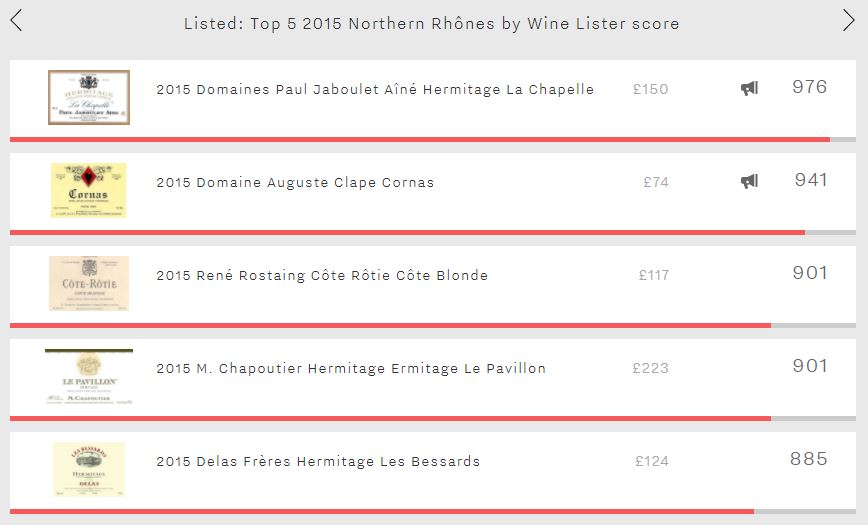
Jaboulet La Chapelle’s outstanding 2015 Quality score – its best since the fabled 1989 vintage – helps it to top the table here with an excellent overall Wine Lister score of 976, 35 points ahead of any other wine. It backs up its excellent quality with the Northern Rhône’s best Brand score (985), and the vintage’s third-best Economics score (941).
In second spot is Clape’s Cornas. Its appearance in the top five is thanks to its 2015 Quality score being 105 points (13%) above its average (937 vs 832). Despite being by far the cheapest of the group, it also achieves the Northern Rhône’s second-best Economics score for the vintage (944) – the result of having added 16.6% to its price over the past six months.
In joint third place with 901 points – just making into the “strongest” band of the Wine Lister 1,000-point scale – are Rostaing’s Côte Rôtie Côte Blonde and Chapoutier’s Ermitage Le Pavillon. Whilst they achieve very similar Quality scores (963 and 975 respectively), their profiles differ elsewhere. Chapoutier’s Le Pavillon possesses a stronger brand (891 vs 849), but interestingly its 2015 Economics score can’t keep pace (752), 19% below its average Economics score (931), and over 100 points below Rostaing Côte Blonde’s score (854).
In fifth place is Delas Frères Hermitage Les Bessards (885). It earns its spot in the group thanks to currently achieving the Northern Rhône’s best Economics score for the vintage (970), thanks to formidable short-term price performance – it has added 26.3% to its price over the past six months alone.
For some, Piedmont is virtually synonymous with the DOCG appellation of Barolo. While wines from this famous appellation rank amongst the very best on Wine Lister, its understated sibling Barbaresco also holds its own, as we discover looking at the top five Barbarescos by Wine Lister score below.
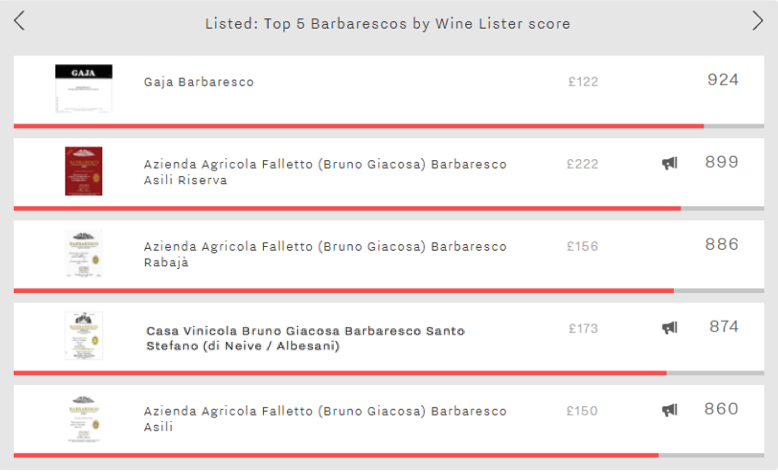
With an overall score of 924, Gaja’s Barbaresco takes the top spot. It leads thanks to its excellent Brand score (977), over 120 points ahead of Barbaresco’s second-strongest brand. As the only one of the group with brand as its strongest suit, Gaja’s Barbaresco is present in 33% of the world’s top restaurants, has the widest range of vintages and formats on each wine list, and receives over five times more searches each month on Wine-Searcher than the second-most popular wine of the group. Consequently, the wine has the joint-highest Brand score of all Piedmont wines – alongside Giacomo Conterno’s Barolo Monfortino Riserva.
Numbers two to five on the list share the same legendary producer. The recently departed Bruno Giacosa has left behind him a formidable legacy, reflected in his four-fold appearance in this top five. The domaine Azienda Agricola Falleto’s and Giacosa’s negotiant arm expressions of Barbaresco excel across all three categories that make up their overall Wine Lister score.
Azienda Agricola Falletto’s Asili Riserva has the best Economics score of all Barbarescos (967), with a compound annual growth rate (CAGR) of 18.5%. It is also the most expensive at £222 per bottle, and most traded of the five.
Giacosa’s Barbaresco Rabajà takes third place, but holds the best Quality score (963) and best long-term price performance (27.0%). The former is reflected in the wine’s impressive average ageing potential of 22 years, five years longer than the Asili Riserva. Indeed, Rabajà 2004, which achieves an outstanding Quality score of 993, has only recently entered its drinking window, and will be drinking well until 2034.
Fourth and fifth spots are taken by Giacosa’s Barbaresco Santo Stefano (di Nieve / Albesani) and Barbaresco Asili. They display very similar profiles, each performing best in the Economics category, followed by Quality, and then Brand. Both wines still rank as “very strong” on the Wine Lister 1000-point scale, with overall scores of 874 and 860 respectively.
This is a poignant week for Azienda Agricola Falletto, with many of the great estate’s wines being released for the first time since the passing of Bruno Giacosa.
The Bordeaux 2015 vintage broke a more lacklustre run since the formidable 2010, and seemed to prove the wine trade legend of vintages ending in 5. En primeur tastings took place at the crest of “Bordeaux Bashing”, with some journalists reluctant to praise the vintage too highly, and there was talk of inconsistency between appellations. Saint-Estèphe was said to have suffered from more rain than its southerly neighbours, for example. Meanwhile in Saint-Emilion, a lack of homogeneity allowed each wine to express its terroir and its identity to the utmost.
Now that the wines have been bottled, it seems a suitable time to revisit the vintage. Our CEO, Ella Lister, has just got back from tasting over 200 wines from across the two banks with Wine Lister’s partner critics Michel Bettane and Thierry Desseauve. She reports Saint-Estèphe as “exceptional and wrongly dismissed as rained-out”, and names Figeac and Canon as two highlights, both “stunning”. The two Saint-Emilion wines are among the top five Quality scores for the vintage on Wine Lister.
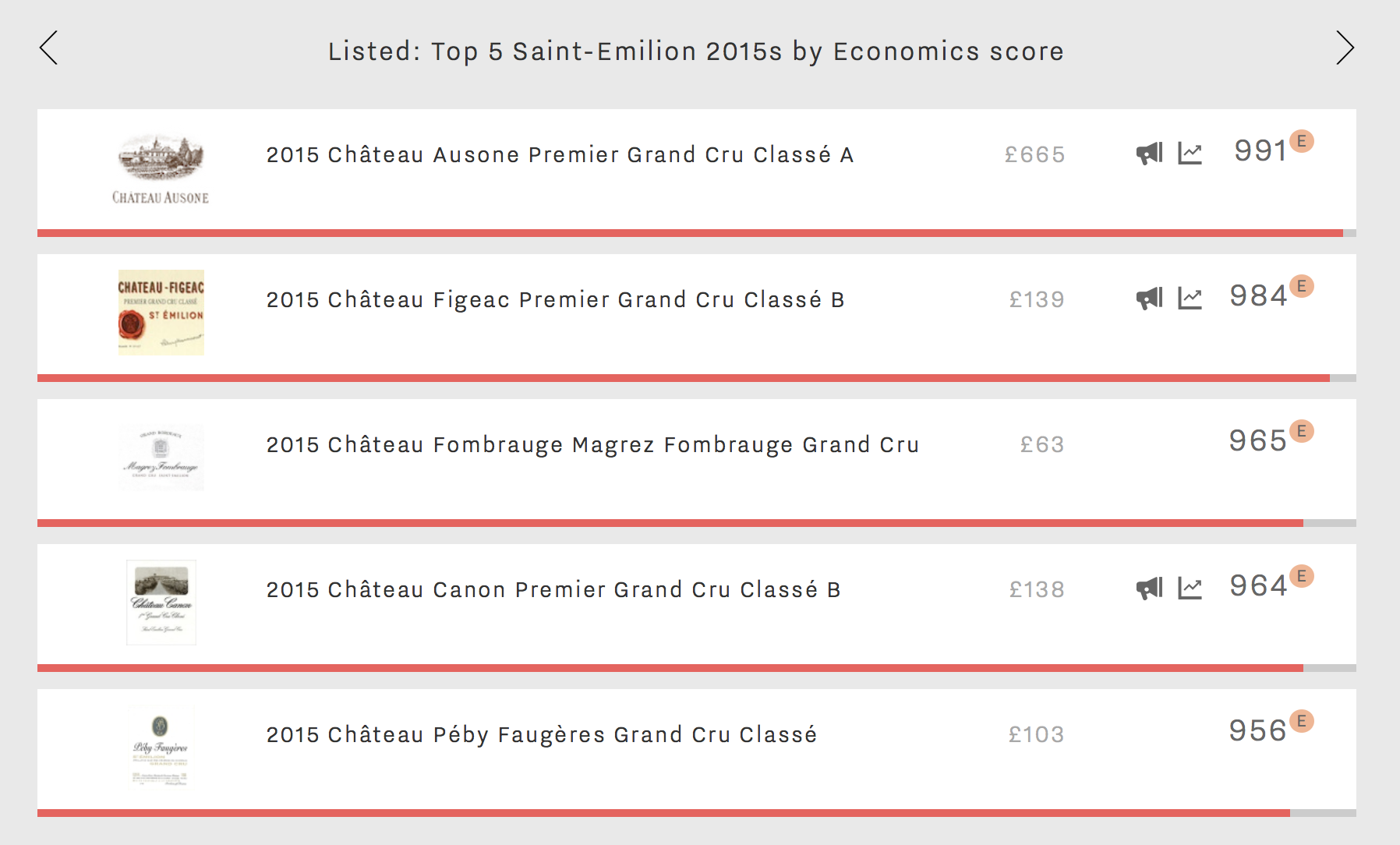
Figeac and Canon both also feature in this week’s top 5: Saint-Emilion 2015 Economics scores, showing that the market recognises their worth. Coming in second and fourth place, both hold premier grand cru classé B status since the reclassification of Saint-Emilion in 2012. Château Figeac 2015 achieves its best Economics score to date with an impressive six-month price performance of 18%.
However, Château Canon is the real surprise here. One of the most talked-about wines by the fine wine trade, its Wine Lister scores are improving from vintage to vintage, with its Economics scores, in particular, soaring. It comes in second place among all Bordeaux wines for Economics score in the 2016 vintage. Both Figeac and Canon are Buzz Brands and also Investment Staples (two of the four Wine Lister Indicators), and so is number one on the list…
Beating both of these is premier grand cru classé A, Château Ausone, with an Economics score of 991 – a record high for this producer, even against the strong 2005 vintage. The château also gains the number one spot across all Saint-Emilion 2015s in Quality, with a score of 990. In the context of overall Wine Lister scores, Ausone is just behind Petrus and Margaux as the third highest-scoring Bordeaux of 2015.
Magrez-Fombrauge and Péby Faugères are the ‘underdog’ entries among Saint-Emilion Economics performers. With Quality and Brand scores ranging from average to strong, the overall score of both wines is “strong” according to the Wine Lister 1,000-point scale (the other three entries sit comfortably in the “strongest” category, with overall scores significantly above 900).
In contrast, one might expect some bigger names, such as Cheval Blanc (a Wine Lister Buzz Brand) to appear higher up the list. Its Economics score of 946 puts it in seventh place, with slower price growth (3% over the last six months). Its price per bottle currently stands at around £500, over five times higher than that of Péby Faugères, and seven times more than Magrez-Fombrauge.
Mention New Zealand, and the first thing that springs to mind will most likely be rugby. The All Blacks are not just the world’s best team, but the foremost brand in rugby. In wine terms, they are the left bank first growths; the team that even people who don’t follow rugby will recognise. Whilst peerless with the oval ball, when it comes to vinous competition New Zealand can’t compete with its Old World counterparts in terms of brand strength. However, as this week’s top five shows, New Zealand’s top brands definitely shouldn’t be discounted.
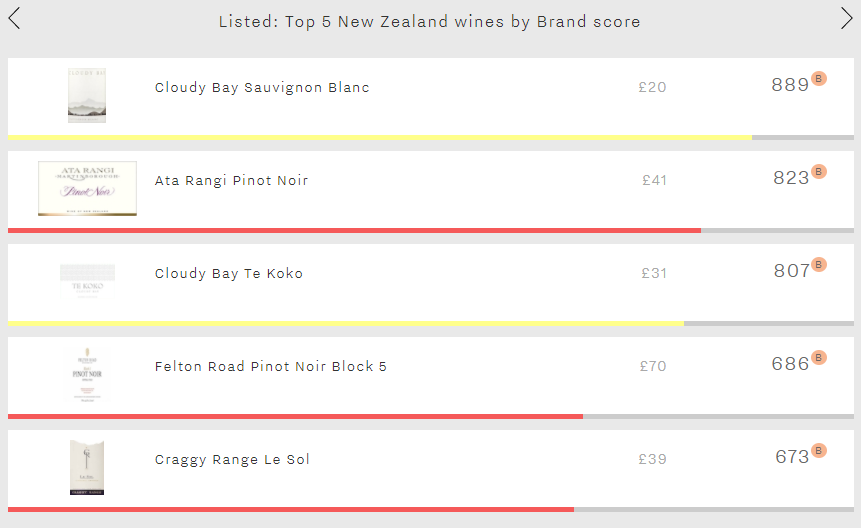
Cloudy Bay fills two of the five spots with its straight Sauvignon Blanc and Te Koko Sauvignon Blanc. With a very strong score of 889 – putting it ahead of the likes of Haut-Brion Blanc – the straight Sauvignon Blanc dominates the rest of the five across both of Wine Lister’s brand criteria. It receives 56% more searches each month on Wine-Searcher than Ata Rangi Pinot Noir (the group’s second-most popular wine). Te Koko – New Zealand’s third-strongest brand (807) – displays a similar profile to the straight Sauvignon Blanc. Its brand is its strongest facet, comfortably outperforming its Quality and Economics scores (614 and 308 respectively).
Whilst Sauvignon Blanc is New Zealand’s foremost white grape, its most prestigious reds are Pinot Noirs, with Ata Rangi’s offering and Felton Road’s Block 5 both appearing in the top five. Ata Rangi is by far New Zealand’s strongest red brand (823). It is the country’s most visible red in the world’s top dining establishments (11%), and also the most popular with consumers, receiving three times as many searches each month as the Felton Road. Whilst it appears in just 7% of top restaurants, Felton Road Block 5 enjoys the group’s best vertical presence, with two vintages / formats offered on average per list. It is also the most expensive of the five. Incidentally, the two Pinot Noirs comfortably achieve the group’s best Quality scores and are the only two with scores above 800 in the category.
Proving that New Zealand isn’t all Sauvignon Blanc and Pinot Noir, Le Sol – Craggy Range’s Syrah – completes the five, with a Brand score of 673.
With Burgundy having dominated our thoughts recently, we thought it was time for a change. So this week, our Listed section continues on its travels, this time stopping in the USA, to consider the country’s overall top five whites. However, whilst the landscape might be different to the Côte d’Or, the grape certainly is not. As might be expected, the USA’s top five whites are all Chardonnays – and all Californian.
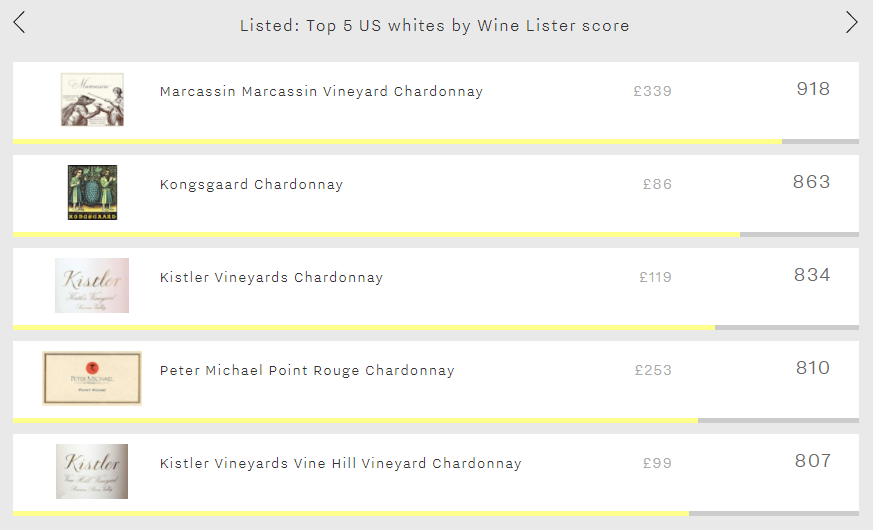
Leading the pack is Marcassin Vineyard Chardonnay, with an excellent score of 918 – putting it amongst the very best on Wine Lister. Its score – 55 points above second-placed Kongsgaard Chardonnay – is the result of excellent consistency across Wine Lister’s three categories. Whilst it comes second in terms of Quality (927), it leads in the Economics category (968), and is well out in front in the Brand category (879). The dominance of its brand is the result of achieving the group’s best restaurant presence – both horizontal and vertical – and being the most popular of the five – it receives nearly twice as many searches each month on Wine-Searcher as the second-most popular wine in the group.
Next comes Kongsgaard Chardonnay (863). The cheapest of the five (£86 per bottle), it experiences the group’s second-weakest Economics score (873). However, it starts to climb back up the table with the group’s third-best Quality score (894), and cements its position with the second-best Brand score of the five (817).
The three final wines in the group are evenly matched, with just 27 points separating Kistler’s straight Chardonnay, Peter Michael’s Point Rouge Chardonnay, and Kistler’s Vine Hill Vineyard Chardonnay. The two Kistlers display contrasting profiles. Whilst the straight Chardonnay comfortably outperforms the Vine Hill Vineyard in the Quality category (892 vs 805), the roles are reversed in the Economics category, with the Vine Hill Vineyard’s very strong three-year CAGR (16.5%) helping it to an excellent score of 951, c.70 points ahead of the straight Chardonnay. In the Brand category, despite achieving very similar scores, again they display contrasting profiles. The straight Chardonnay is over twice as popular as the Vine Hill Vineyard, but features in half the number of the world’s top restaurants.
Peter Michael Point Rouge Chardonnay – the USA’s fourth-best white – has a somewhat topsy-turvy profile. It enjoys the group’s best Quality score (933), but the worst Brand and Economics scores (641 and 827 respectively). Thanks to an extraordinary three-year CAGR of 47.7% it is also by far the most-expensive of the five, with a three-month average price of £457.
Today marks the close of a busy week of Burgundy 2016 en primeur tastings, with offer prices largely stable on 2015 despite tiny volumes, thanks to the more generous 2017 in the wings. However, prices have been escalating in the secondary market for several years now, with eight of the region’s top wines averaging more than £3,000 per bottle). Eyewatering, yes, but as illustrated in our recently published study, the majority of the region’s top wines are priced between £100 and £500.
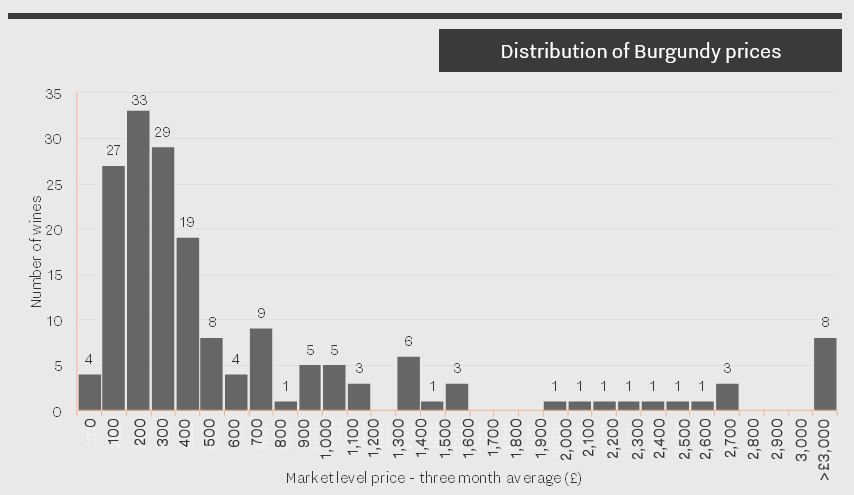
To mark this week’s Burgundy en primeur tastings, the latest Listed section picks out the top five red Burgundies priced under £300 per bottle by Wine Lister score. With an outstanding average score of 913 – putting them amongst the very strongest on Wine Lister – and four of the five achieving Buzz Brand status, these wines are worth the price tag.
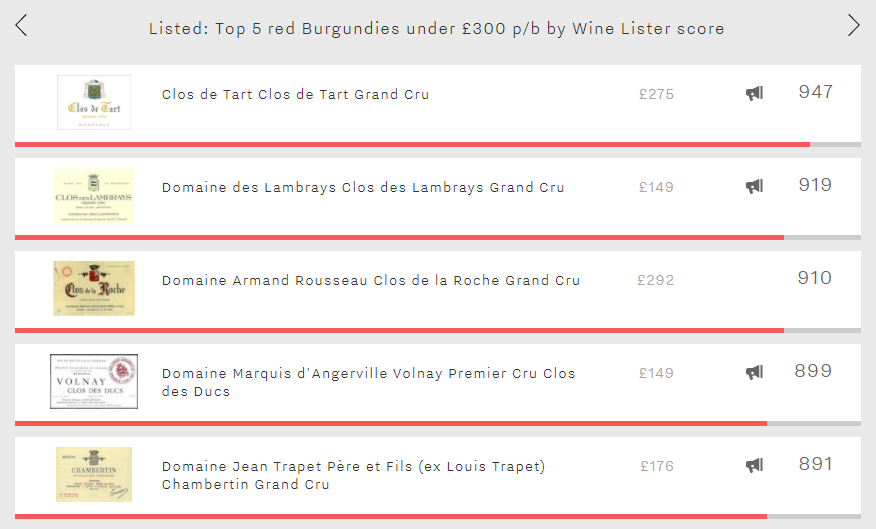
Leading the way is Grand Cru monopole Clos de Tart with a score of 947. Recently acquired by Artemis Domaines – Latour owner François Pinault’s holding company – it achieves the best Brand and Economics scores of the group (956 and 964 respectively), and is just pipped into second place in the Quality category by Trapet Père et Fils Chambertin Grand Cru (932 vs 940). Its price has increased 9% over the past six months, and now at £275, it looks like it won’t qualify for this group much longer!
Next comes Domaine des Lambrays Clos des Lambrays – part of LVMH’s portfolio since 2014 – with a score of 919. Alongside Marquis d’Angerville Volnay Premier Cru Clos des Ducs, this is the cheapest (or least expensive) of the group (c.£150 each). It enjoys its best score in the Brand category, with the group’s highest level of restaurant presence (25%), and the second-best average monthly online search frequency (5,079).
In third place is Rousseau’s Clos de la Roche Grand Cru with a score of 910. At almost £300 per bottle, it is the most expensive of the group, contributing to its boasting the best score in the Economics category (937). It is also partner critic Jeannie Cho Lee’s favourite wine of the group; she awards it a score of 95/100 on average.
Dropping just below the 900-point mark are Marquis d’Angerville Volnay Premier Cru Clos des Ducs and Trapet Père et Fils Chambertin Grand Cru (899 and 891 points respectively). They display very different profiles. The latter leads the Quality category, with the former lagging 60 points behind (still with a very strong score of 879). However,Trapet’s Chambertin struggles in other categories, with the group’s lowest scores for Brand and Economics (867 and 823). Meanwhile, thanks to the group’s strongest long and short-term growth rates, Marquis d’Angerville’s Volnay Clos des Ducs enjoys an excellent Economics score (939) – the second-best of the five.
If you’d like to discover more about Burgundy and its top wines, then click here if you are a subscriber to view the full regional study, or here to see a preview if you haven’t yet subscribed.
December is an expensive month, a time when many of us push the boat out, embracing the seasonal festivities as the days get ever shorter and the nights longer. But December has now been and gone, and January is here. Whilst it is a time for trying to tighten one’s belt – economically and physically – it needn’t be all doom and gloom.
This is where Wine Lister’s Value Picks come in to their own. One of Wine Lister’s four indicators (designed to highlight particularly noteworthy wines for our subscribers), Value Picks identify the wines and vintages that have the best quality to price ratio (with a proprietary weighting giving more importance to quality, thus giving the finest wines a look-in). This week’s Listed section looks at Spain’s top five Value Picks. Each achieving Quality scores of at least 876, and costing under £40 per bottle, they are sure to brighten up these dark January days. Please note that the prices shown are excluding duty and VAT, and often reflect prices available only when purchasing a full case.
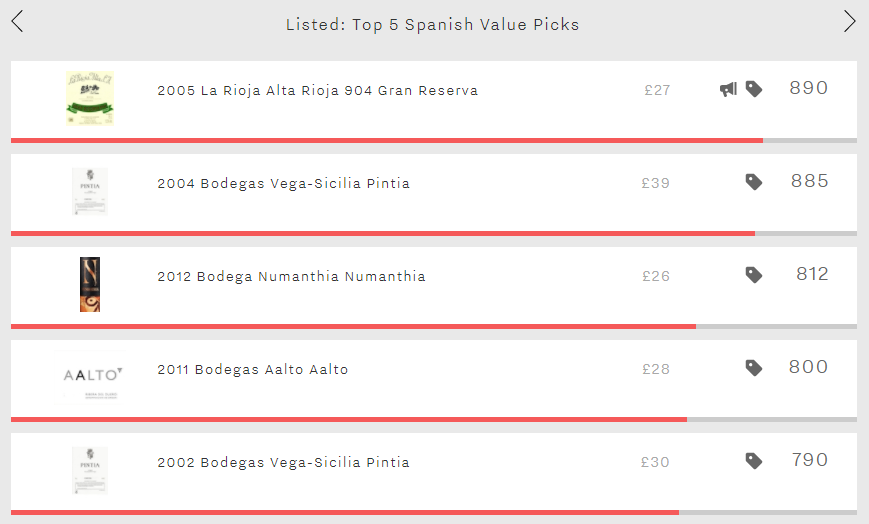
Leading the way is La Rioja Alta Rioja 904 Gran Reserva 2005. With an excellent Quality score of 909, this is a wine that is built to last – it is only now entering its drinking window, and will be drinking well until 2032. Not only does it qualify as a Value Pick, it is also one of Wine Lister’s Buzz Brands. Available for as little as £27 per bottle, it represents outstanding value.
Vega-Sicilia Pintia fills two spots, with the 2004 and 2002. They enjoy the group’s top two highest Quality scores (987 and 965 respectively), having received excellent ratings of 19/20 and 18/20 from Wine Lister partner critic Jancis Robinson. They need drinking up now, so why not start the year as you mean to go on and get your hands on one (or both!) of these.
Numanthia 2012, on the other hand, won’t be ready until 2022. The cheapest of the group – at as little as £26 per bottle – it might be wise to buy a case and forget about it for a few years. Achieving a Quality score of 876, you won’t regret finding a bottle of it tucked away in January 2028!
The last of Spain’s top five Value Picks is Aalto 2011. With a Quality score of 920, and right in the middle of its drinking window, it would be £28 of liquid Spanish sun to brighten up the month.











